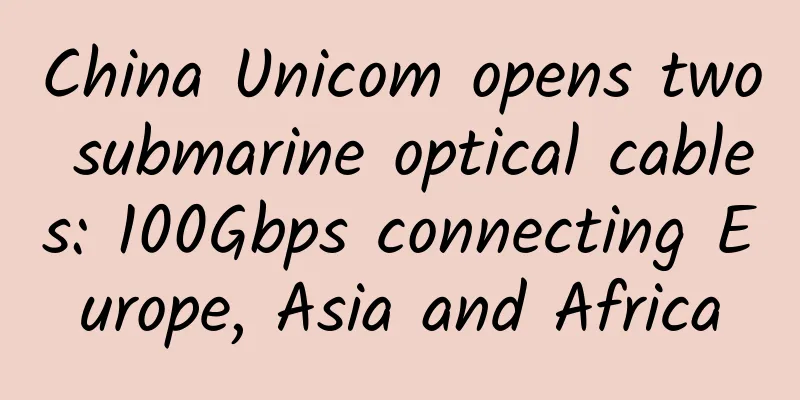China Unicom opens two submarine optical cables: 100Gbps connecting Europe, Asia and Africa

|
Recently, China Unicom officially announced that the Asia-Europe 5 (SMW5) and Asia-Pacific Direct (APG) submarine optical cables have been officially opened and put into use recently. After the two submarine cables were interconnected at the neutral POP (network service provider point) in Singapore, a high-bandwidth channel was opened up from Asian countries such as mainland China, Japan, and South Korea to Africa and Europe. The bandwidth reached 100Gbps (12.5GB/s), which is equivalent to transmitting two or three 720p high-definition movies in one second.
The Asia-Pacific Direct Submarine Cable was financed and constructed by China Unicom in collaboration with domestic and foreign operators. It connects eight countries and regions including mainland China, Taiwan, Hong Kong, South Korea, Japan, Vietnam, Malaysia and Singapore. The system has a designed capacity of over 54Tbps and extends directly to the neutral POP point in Singapore. Among them, China Unicom provides a landing station in Shanghai Nanhui in China, and also has landing points in Shanghai Chongming and Hong Kong. The Asia-Europe 5 submarine cable, in which China Unicom participated in the investment and construction, connects 19 countries including Singapore, Malaysia, Indonesia, Bangladesh, Sri Lanka, Myanmar, Pakistan, Djibouti, Saudi Arabia, the United Arab Emirates, Egypt, Turkey, Italy and France. The backbone section has a designed capacity of 24Tbps and extends directly to neutral POP points in France, Italy and Singapore. With the opening of these two submarine cables, China Unicom has extended the "Maritime Silk Road" to Japan and South Korea, opening a new era of the "Maritime Silk Road" information highway. According to China Unicom's global network planning, the Asia-Europe 5 and Asia-Pacific direct submarine cables will also be connected to the soon-to-be-opened Asia-Africa-Europe 1 (AAE-1) submarine cable, realizing dual routing in the Asia-Africa-Europe direction and protecting each other. The Asia-Europe-Africa 1 submarine cable will, together with the Asia-Europe 5 submarine cable, connect 14 countries including Singapore, Malaysia, Myanmar, India, Pakistan, Qatar, the United Arab Emirates, Oman, Yemen, Djibouti, Saudi Arabia, Egypt, France, and Italy, and also connect to Indonesia, Sri Lanka, Bangladesh, and Türkiye. The completion of these submarine cables will improve China Unicom's international network layout in Asia, Africa and Europe, reduce communication latency, and greatly enhance the communication capabilities and security of the overall network. |
<<: The main tasks of 5G in the 13th Five-Year Plan are determined
>>: Current status of Chinese domain names: low application level and potential security risks
Recommend
IDC: Global edge computing market will reach $250.6 billion in 2024
Industry data: Gartner conducted a survey and int...
What exactly is fast charging?
1. Definition of fast charging [[343166]] There i...
How to Choose the Right Switch for Your Network?
When it comes to networking, switches are crucial...
Dedicated 5G networks for smart sports stadiums and venues
Advances in technology are dramatically changing ...
The current status of 5G and new initiatives of the three major telecommunications operators
After entering 2021, the movement of 5G construct...
Yunhai: A complete cloud server management system developed based on JAVA+NET
As we know, Standard Interconnect is a business t...
Verizon installs 5G equipment outside homeowners' homes, sparking complaints
According to foreign media, the US telecommunicat...
[Black Friday] HawkHost virtual hosts up to 30% off, reseller hosts up to 50% off, cloud servers up to 30% off
HawkHost's Black Friday promotion starts at 1...
Research on 4G network coverage quality assessment method in rural areas
Labs Guide The analysis of 4G coverage quality in...
Innovative ICT to build a smart airport
In the era of globalization, airports have become...
AI-powered platforms enable business agility, help operators achieve digital transformation and achieve business success
[Shenzhen, China, July 30, 2020] Today, at the &q...
Ten ways for Vue.js parent-child component communication
[[266702]] Interviewer: What are the ways for par...
The curtain is about to be raised on 5G commercial use, will the industry be reshuffled?
Recently, Miao Wei, Minister of Industry and Info...
Performance Tuning: The RocketMQ timeout exception that has troubled me for half a year has finally been solved
[[398458]] In the intranet environment, there was...
F5 Networks Appoints Adam Judd to Lead APAC Sales Efforts to Accelerate Growth of Cloud and Security Business in the Region
Beijing, March 21, 2017 – Today, F5 Networks anno...









![[11.11] CUBECLOUD 15% off all items, Los Angeles special monthly payment starting from 20 yuan, annual payment buy one get one free](/upload/images/67cac23ae4621.webp)